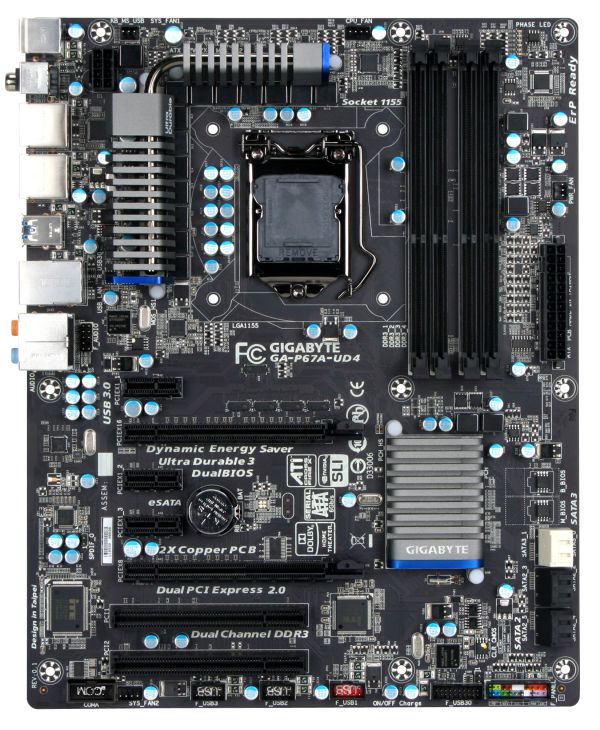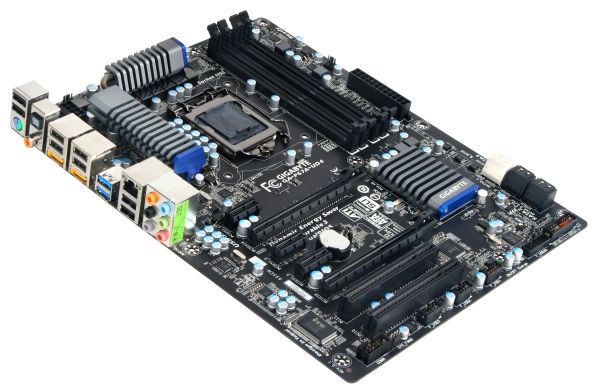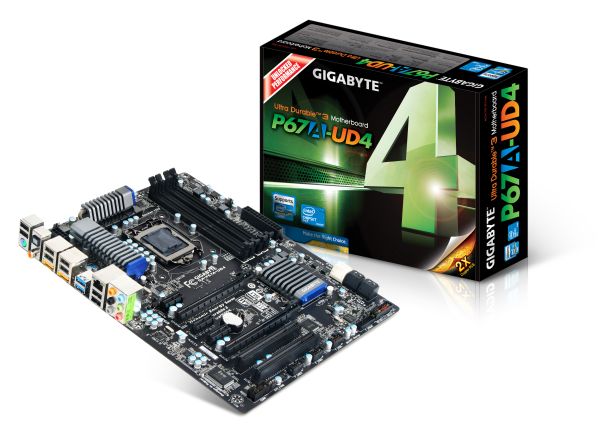The Battle of the P67 Boards - ASUS vs. Gigabyte at $190
by Ian Cutress on January 20, 2011 4:15 PM EST- Posted in
- Motherboards
- Gigabyte
- Asus
- P67
Gigabyte has five P67 motherboards up for the US Sandy Bridge release – the P67A-UD3, the P67A-UD3P, the P67A-UD4, the P67A-UD5 and the P67A-UD7. At least the naming scheme is as easy to follow as previous generations – the higher the last number, the more expensive the board and the more features on offer:
| P67A Series | |||||
| P67A-UD3 | P67A-UD3P | P67A-UD4 | P67A-UD5 | P67A-UD7 | |
| Price | $130 | $160 | $190 | $260 | $320 |
|
SATA 6 Gb/s SATA 3 Gb/s eSATA |
2 4 0 |
2 4 0 |
2 4 2 |
2 4 2 |
4 4 2 |
|
CrossFireX SLI |
Yes No |
Yes No |
Yes Yes |
Yes Yes |
Yes Yes |
|
USB 3.0 USB 2.0 |
2 12 |
4 14 |
4 14 |
8 10 |
10 8 |
| LAN | 1 | 1 | 1 | 1 | 2 |
| PCIe |
2 x16 (1 x16, 1 x4) |
2 x16 (1 x16, 1 x4) |
2 x16 (2 x8) |
3 x16 (2 x8, 1 x4) |
4 x16 (2 x16 or 4 x8) |
Visual Inspection
One of the first things I noticed about the P67A-UD4 was that it was not blue and white, like the majority of the Gigabyte motherboards have been recently that I have worked with. Predominantly featuring a black PCB, black PCIe connectors, black DIMM slots, black SATA 3Gb/s ports, a splash of white for SATA 6GB/s, silver chipset/FET coolers and a hint of old Gigabyte blue on those coolers is what we get this iteration. Not the whole range is like this – I have a H67 Gigabyte board on my desk here and that retains the blue and white credentials, as does the P67A-UD3.
The PCIe layout is slightly different to other P67 boards I have reviewed – with only two PCIe x16 slots (going to x8/x8 in dual GPU mode), there is an extra PCIe x1 slot on the board. In a dual GPU setup, this leaves two PCIe x1 and a PCI slot still free on the board, as well as a gap between dual slot GPUs to aid in cooling.
Fan headers on the board are located near the 8-pin power connector, one above the socket, one above the 24-pin power connector, and one below the PCIe slots, which would only be covered if you have a dual slot PCI card.
Gigabyte’s dual BIOS system is on this board. Yes, that is right – BIOS. No UEFI here. Well, that's not strictly true, as one of the latest BIOS updates at the time of writing (F6) implements an EFI into the BIOS, reportedly allowing bootable access to hard drives over 2.2TB. This is due to, as Gigabyte explained, that their board is actually UEFI, but without a proper GUI interface like other boards. They've used the old BIOS-style interface for now, as after years of plugging away they believe it's quick, stable and recognisable for consumers to understand. So underneath, it's truly 64-bit, meaning 2.2TB+ partition support is possible, and could also suggest that a new GUI is coming in the future. I asked about time-scale for this, but Gigabyte were undoubtedly tight-lipped about dates and implementations.
Visually, in terms of the board, there is not much else to say – the space between the socket and the PCI slots is virtually clear. There are no power, reset or clear CMOS buttons on board, neither is there a debug LED, and which is a real shame given that ASRock can do it on a $150 motherboard. Compared to the ASUS board, all the energy saving and turbo performance options are all software based – no easy flick of switches here.
Like the other P67 boards, the back panel is regular as well. Only a single PS/2 connector, 8 USB 2.0 ports, 2 USB 3.0 ports, 2 eSATA ports, S/PDIF Out connectors, a single gigabit Ethernet, and audio I/O.














137 Comments
View All Comments
strikeback03 - Friday, January 21, 2011 - link
What board was that? As I have hardly seen any P965 boards which had BIOS updates to support Penryn, let alone older chipsets.I'd imagine the short answer is that it helps Intel's bottom line, and until AMD can produce stuff that competes in performance as well as price Intel will continue to gouge for the chipsets. Also Nvidia charges to SLI certify boards, which is probably why the board makers don't include it in cheaper boards.
Hrel - Friday, January 21, 2011 - link
Asus P5NE-SLI built on the Nvidia 650i SLI chipset.medi01 - Sunday, January 23, 2011 - link
Makes me wonder, how much do they pay for the chipset.I recall buying AMD motherboards supporting the latest CPUs for 50-70$.
Hrel - Thursday, January 20, 2011 - link
I agree with your conclusion whole heartedly. AsRock has really had their game together this past year or so and they don't seem to be slowing down at all. I used to be a strictly Asus guy but AsRock is looking like it'll be the heart to my next build.airgreek - Thursday, January 20, 2011 - link
you do know that Asrock is owned by Asus right? I have been in the PC game a LONG time back when Abit was the mobo to own. I only consider three brands for mobo's now (from experience) and those are MSI, Gigabyte, and EVGA. EVGA has INCREDIBLE customer service, while Gigabyte uses solid material to build their boards. MSI is not far behindPeanutsrevenge - Thursday, January 20, 2011 - link
I agree completely, I LOVE EVGA stuff, it's just not usually suitable for what my customers want, so I don't get to play with their stuff often :(lpjz290 - Friday, January 21, 2011 - link
even though ASrock is a ASUS subsidiary, they are now also considered a competitor ever since they were listed on the taiwan stock exchange. now that they have produced a board that can perform very close to ASUS P8P67 PRO at a considerably lower price, i'd say these two companies could very well be fighting against each other more often in future (which is gd for ASUS as a whole anyway).Hrel - Friday, January 21, 2011 - link
they broke off from Asus, actually.Heloc - Sunday, January 23, 2011 - link
AS of June 2010 ASUS is no longer the majority owner of ASRock but they spun off by issuing shares to ASUS shareholders so both companies have the same board of directors.There is more separation than there was but still than separation than in a simple spin-off.
mckirkus - Thursday, January 20, 2011 - link
If you're doing any surround sound gaming you'll probably want the UD4. It enables Dolby Digital Live which means you can run one optical cable to a receiver and get real surround sound with games without having to resort to a bunch of analog cables. I was about to get a $100 sound card but the UD4 makes that unnecessary.